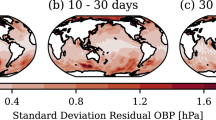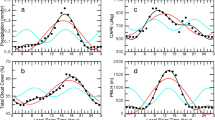Abstract
The coupled models of both the Global Ocean-Atmosphere-Land System (GOALS) and the Atmosphere-Vegetation Interaction Model (GOALS-AVIM) are used to study the main characteristics of interannual variations. The simulated results are also used to investigate some significant interannual variability and correlation analysis of the atmospheric circulation and terrestrial ecosystem. By comparing the simulations of the climate model GOALS-AVIM and GOALS, it is known that the simulated results of the interannual variations of the spatial and temporal distributions of the surface air temperatures and precipitation are generally improved by using AVIM in GOALS-AVIM. The interannual variation displays some distinct characteristics of the geographical distribution. Both the Net Primary Production (NPP) and the Leap Area Index (LAI) have quasi 1–2-year cycles. Meanwhile, precipitation and the surface temperatures have 2–4-year cycles. Conditions when the spectrum density values of GOALS are less than those of GOALS-AVIM, tell us that the model coupled with AVIM enhances the simulative capability for interannual variability and makes the annual cycle variability more apparent. Using Singular Value Decomposition (SVD) analysis, the relationship between the ecosystem and the atmospheric circulation in East Asia is explored. The result shows that the strengthening and weakening of the East Asian monsoon, characterized by the geopotential heights at 500 hPa and the wind fields at 850 hPa, correspond to the spatiotemporal pattern of the NPP. The correlation between NPP and the air temperature, precipitation and solar radiation are different in interannual variability because of the variation in vegetation types.
Similar content being viewed by others

References
Brovkin, V., 2002: Climate-vegetation interaction. J. Physics, 4, 57–72.
Bretherton, C. S., C. Smith, and J. M. Wallace, 1992: An intercomparison of methods for finding coupled patterns in climate data. J. Climate, 5(6), 541–560.
Charney, J. G., P. H. Stone, and W. J. Quirk, 1975: Drought in Sahara biogeophysical feedback mechanism. Science, 187, 434–435.
Claussen, M., 1997: Modeling bio-geophysical feedback in the African and Indian monsoon region. Climate Dyn., 13, 247–257.
Cramer, W., and Coauthors, 2001: Global response of terrestrial ecosystem structure and function to CO2 and climate change: Results from six dynamic global vegetation models. Global Change Biology, 7, 357–373.
Dan, L., 2003: Simulation of multi-scale variation in the two-way interaction model between biosphere and atmosphere. Ph. D. dissertation, Institute of Atmospheric Physics, Chinese Academy of Sciences, 192pp. (in Chinese)
Dan, L., and J. J. Ji, 2007: The surface energy, water, carbon flux and their intercorrelated seasonality in a global climate-vegetation coupled model. Tellus(B), 59(3), 425–438.
Dan, L., J. Ji, and Y. Li, 2002: Climate simulate based on a different-grid nested and coupled model. Adv. Atmos. Sci., 19(3), 487–499.
Dan, L., J. Ji, and Y. He, 2007: Use of ISLSCP II data to intercompare and validate the terrestrial net primary production in a land surface model coupled to a general circulation model. J. Geophys. Res., 112, D02S90. doi: 10.1029/2006JD007721.
Dan, L., J. J. Ji, and Y. P. Li, 2005: Climatic and biological simulations in a two-way coupled atmospherebiosphere model (CABM). Global and Planetary Change, 47, 153–169.
Friedlingstein, P., P. Cox, R. Betts, L. Bopp, W. Von Bloh, V. Brovkin, P. Cadule, and S. Doney, 2006: Climate-carbon cycle feedback analysis: Results from the C4MIP Model intercomparison. J. Climate, 19(14), 3337–3353.
Fu, C., G. Wen, L. Xie, M. Zhao, and H. Yuan, 2002: The diagnosis and simulation studies on climate and ecosystem interactions in East Asia monsoon region. Journal of Nanjing University (Natural Sciences), 38(3), 281–294. (in Chinese)
Gao, L., X. An, and Q. Liu, 2004: 500 hPa Circulation variation and precipitation abnormity during Shandong spring. Scientia Meteorologica Sinica, 24(4), 440–447. (in Chinese)
Gu, J., J. Zhang, and J. Chao, 1994: Atmospheric Science Dictionary. China Meteorological Press, Beijing, 980pp. (in Chinese)
He, Y., W. Dong, J. Ji, and L. Dan, 2005: The net primary production simulation of simulation terrestrial ecosystems in china by AVIM. Adv. Atmos. Sci., 20(3), 345–349.
Huang, J., 2004: The Methods of Statistical Analysis and Prediction in Meteorology. Meteorological Press, Beijing, 298pp. (in Chinese)
Iwasaka, N., and J. M. Wallace, 1995: Large scale air sea interaction in the Northern Hemisphere from a view point of variations of surface heat flux by SVD analysis. J. Meteor. Soc. Japan, 73, 781–794.
Ji, J. J., 1995: A climate-vegetation interaction model: Simulating physical and biological processes at the surface. Journal of Biogeography, 22, 445–451.
Ji, J., and L. Yu, 1999: A Simulation study of coupled feedback mechanism between physical and biogeochemical processes at the surface. Chinese J. Atmos. Sci., 23(4), 439–448. (in Chinese)
Levis, S., G. B. Bonan, and P. J. Lawrence, 2007: Presentday springtime high-latitude surface albedo as a predictor of simulated climate sensitivity. Geophys. Res. Lett., 34, L17703, doi: 10.1029/2007GL030775.
Li, Y., and C. Li, 2001: Singular value decomposition analysis of air temperature in spring in Sichuan Province and Chongqing city and 500 hPa geopotential height. Plateau Meteorology, 20(2), 165–172. (in Chinese)
Liu, H, and G.-X. Wu, 1997: Impacts of land surface on climate of July and onset of summer monsoon: A study with an AGCM plus SSiB. Adv. Atmos. Sci., 14(3), 289–308.
Liu, H., X. Jin, X. Zhang, and G. Wu, 1996: A coupling experiment of an atmosphere and an ocean model with a monthly anomaly exchange scheme. Adv. Atmos. Sci., 13(2), 133–146.
Liu, H., X. Zhang, and G.-X. Wu, 1998: Cloud feedback on SST variability in western equatorial Pacific in a CGCM. Adv. Atmos. Sci., 15(3), 410–423.
Matthews, H. D., M. Eby, T. Ewen, P. Friedlingstein, and B. J. Hawkins, 2007: What determines the magnitude of carbon-cycle-climate feedbacks? Global Biogeochemical Cycles, 21, GB2012, doi: 10.1029/2006GB002733.
Nemani, R. R., C. D. Keeling, H. Hashimoto, W. M. Jolly, S. C. Piper, C. J. Tucker, R. B. Myneni, and S. W. Running, 2003: Climate-driven increases in global terrestrial net primary production from 1982 to 1999. Science, 300, 1560–1563.
Notaro, M., S. Vavrus, and Z. Liu, 2007: Global vegetation and climate change due to future increases in CO2 as projected by a fully coupled model with dynamic vegetation. J. Climate, 20, 70–90.
Pielke Jr., R. A., 1998: Rethinking the role of adaptation in climate policy. Global Environmental Change, 8(2), 159–170.
Prentice, I. C., M. Heimann, and S. Sitch, 2000: The carbon balance of the terrestrial biosphere: ecosystem models and atmospheric observations. Ecological Applications, 10, 1553–1573.
Prohaska, J. T., 1976: A technique for analyzing the linear relationships between two meteorological fields. Mon. Wea. Rev., 104(11), 1345–1353.
Schlesinger, M. E., and X. Jiang, 1991: Revised projection of future greenhouse warming. Nature, 350, 219–221.
Sellers, P. J., and Coauthors, 1997: Modeling the exchanges of energy, water, and carbon between continents and the atmosphere. Science, 275, 502–509.
Shen, S., and K.-M. Lau, 1995: Biennia oscillation associated with the East Asian summer monsoon and tropical sea surface temperatures. Journal of the Meteorological Society of Japan, 73(1), 105–124.
Shi, N., F. Y. Wei, G. L. Fen, and T. L. Shen, 1997: Monte Carlo test used in correlation and composite analysis of meteorological fields. Journal of Nanjing Institute of Meteorology, 20(3), 355–359. (in Chinese)
Sitch, S., and Coauthors, 2003: Evaluation of ecosystem dynamics, plant geography and terrestrial carbon cycling in the LPJ dynamic global vegetation model. Global Change Biology, 9, 161–185.
Tang, X., W. Qian, and P. Liang, 2006: Climatic features of boundary belt for East Asian summer monsoon. Plateau Meteorology, 25(3), 275–281. (in Chinese)
Texier, D., and Coauthors, 1997: Quantifying the role of biosphere-atmosphere feedback in climate change: Coupled model simulation for 6000 BP and comparisons with palaeodata for other Eurasia and northern Africa. Climate Dyn., 13, 865–882.
Wallace, J. M., C. Smith, and C. S. Bretherton, 1992: Singular value decomposition of wintertime sea surface temperature and 500mb height anomalies. J. Climate, 5(6), 561–576.
Wang, Z., A.-S. Cochelin, L. A. Mysak, and Y. Wang, 2005: Simulation of the last glacial inception with the green McGill Paleoclimate Model. Geophys. Res. Lett., 32, L12705, doi: 10.1029/2005GL023047.
Wei, F., Y. Ding, J. Yang, and R. Wang, 2005: SVD analysis of the relationship between 500 hPa height fields and precipitation fields in rainy season in Northwest China. Arid Meteorology, 23(4), 17–23. (in Chinese)
Woodward, F. I., M. R. Lomas, and R. A. Betts, 1998: Vegetation-climate feedbacks in a greenhouse world. Philosophical Transactions of the Royal Society of London(B), 353, 29–38.
Wu, H.-B., and L. Wu, 2005: Methods for Diagnosing and Forecasting Climate Variability. Meteorological Press, Beijing, 371pp. (in Chinese)
Wu, G.-X., H. Liu, Y. Zhao, and W.-P. Li, 1996: A ninelayer atmospheric general circulation model and its performance. Adv. Atmos. Sci., 13(1), 1–18.
Wu, G.-X., X.-H. Zhang, H. Liu, and Y.-Q. Yu, 1997: Global ocean-atmosphere-land system model of LASG(GOALS/LASG) and its performance in simulation study. Quarterly Journal of Applied Meteorology, 8(Suppl.), 15–28. (in Chinese)
Yu, Y.-Q., 1997: Design of ocean-sea ice-atmosphere coupling scheme and numerical simulation of interdecadal climate variability. Ph. D. dissertation, Institute of Atmospheric Physics, Chinese Academy of Sciences, 130pp. (in Chinese)
Yu, Y.-Q., and X.-H. Zhang, 1998: A modified air-sea flux anomaly coupling scheme. Chinese Science Bulletin, 43, 866–870. (in Chinese)
Zhang, J., C. Fu, and X. Yan, 2002: Global respondence analysis of LAI versus surface air temperature and precipitation variations. Chinese Journal of Geophysics, 45(5), 631–637. (in Chinese)
Zhang, X., K. Chen, X. Jin, W. Lin, and Y. Yu, 1996: Simulation of thermohaline circulation with a twenty-layer oceanic general circulation model. Theoretical and Applied Climatology, 55(1–4), 65–87.
Zheng, Y., G. Yu, and B. Xue, 2004: Simulate of East Asian climate at 6ka B. P.. Quaternary Sciences, 24(1), 28–38. (in Chinese)
Author information
Authors and Affiliations
Corresponding author
Rights and permissions
About this article
Cite this article
Zhi, H., Wang, P., Dan, L. et al. Climate-vegetation interannual variability in a coupled atmosphere-ocean-land model. Adv. Atmos. Sci. 26, 599–612 (2009). https://doi.org/10.1007/s00376-009-0599-6
Received:
Revised:
Published:
Issue Date:
DOI: https://doi.org/10.1007/s00376-009-0599-6



